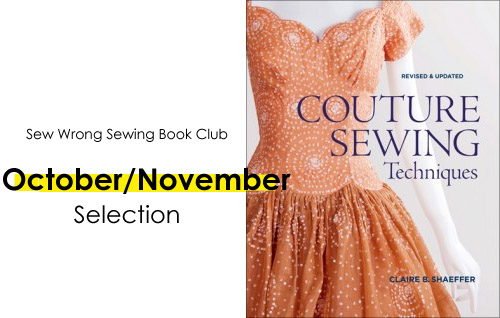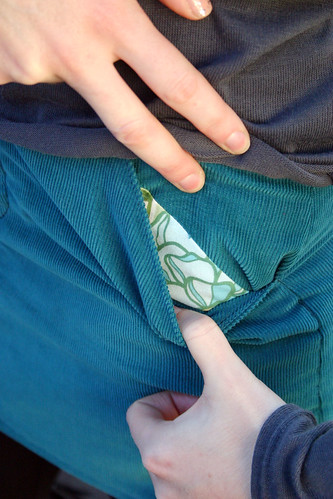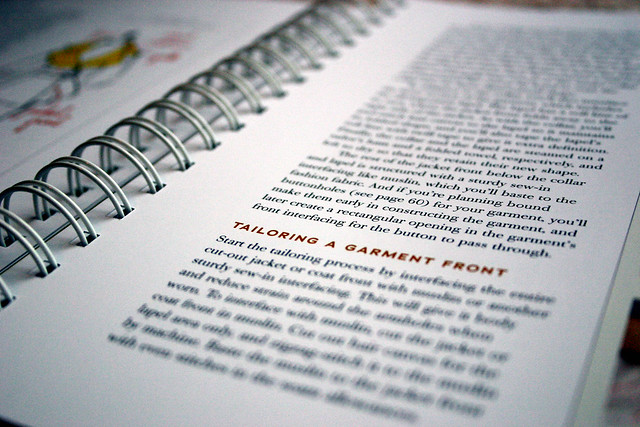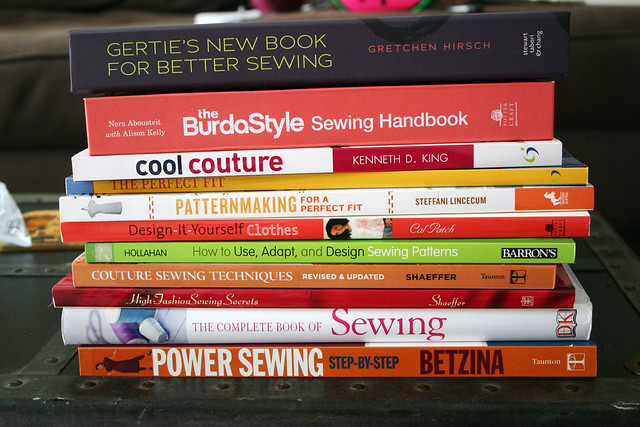
Why, hello there sewing book readers! You may have noticed some lag-time between our first book and this one. My apologies – the advent of the holiday season caught me off guard and left me with little time to properly review this book. Let’s just make this our October/November book and pick up from there, shall we?
From the back of the book:
“With clarity and a profound respect for technique and application, Claire Shaeffer brings one into an haute-couture atelier, where the realm of possibility has no boundaries. She imparts the secrets of hand-work that allow a garment to become weightless, a wisp of dimension for the wearer. She pays homage to the gods of the craft and bows to the church of haute couture.”
And
Claire B. Shaeffer’s authoritative guide goes beyond couture sewing: an all new chapter on designing with special fabrics; gorgeous photos, step-by-step illustrations, and concise technical instruction; trade secrets and insider tips from an international expert on couture
There’s no doubt about it: Claire Shaeffer is a couture sewing guru. I knew when I picked up this book this summer that I would learn a lot from her experience behind-the-scenes in haute couture design houses.
Knowing very little about couture sewing to begin with (read: almost nothing), I appreciated the way the book was set up to guide me in the right direction for what I wanted to do. The book is divided into two parts: the first being “The Basics” of couture sewing, the second “Applying” the techniques. For those interested, Claire goes into detail about the history of couture sewing and what couture sewing looks like today, the differences between haute couture and ready-to-wear garments, and even explains the uses of different types of hand-sewing thread (who knew?). I skimmed most of that section since I had already learned quite a bit from Gertie’s book about couture sewing, but then skipped on to the application portion of the book. That’s what we’re here for, right??
There were two projects that I made using the techniques from this book: my zombie skirt and Moss Mini Skirt.
Zombie Skirt: Since I was sewing with a heavy cotton flannel, I wanted to avoid a bulky waistband on my skirt. Flipping to the Skirts and Pants section, I found just what I was looking for: a faced waistline a la Chanel. Instead of using self-fabric for a waistband facing, I used grosgrain ribbon to achieve the same effect without the bulk. I loved it! I highly recommend this technique for garments requiring a waistband facing – it gives the garment more of a “J Crew” effect in the inside. I also inserted a hand-picked zipper to the back of the skirt following her instructions for a Slot Zipper (and also using Gertie’s instructions in her book as well). Not sure if I’d try that again since I wasn’t too happy with the results but I’m guessing it’s a technique that needs practice in order to achieve a crisp, finished look.
Moss Mini: encouraged by this book, I took a stab at top-stitching most of the seams on this skirt. Not totally a couture sewing technique, but Claire claims that it’s an “elegant and versatile trim,” and why wouldn’t I want that for my skirt! I patiently stitched down all of my main seams with a contrasting gray thread and panicked when I realized that my stitching down the back of my skirt wasn’t even, thinking that I would need to rip it all out and start again. But have no fear! Claire writes that I shouldn’t “worry if the topstitching is not perfectly regular; Chanel’s is not always perfect either.” Well there! If it’s ok for Chanel, it’s ok for my corduroy skirt.
I think this book would have been more useful if I was sewing a more complicated project, like a jacket or fancy dress. When that day arrives, I will be reaching for this book for sure. It’s chock-full of information that the more advanced stitcher can use to elevate a home sewn garment from Holly Hobby to Holly Golightly (ok that’s kinda cheesy, I admit).
Have you used this book for any of your sewing in the past/present? What did you think of it? Did you find it useful?
And now, for the unveil of next month’s book:

I’ve been itching to draft some of my own pattern ideas I have floating around in my head and wanted to give a shout-out to this book. If you haven’t yet tried Design-It-Yourself Clothes by Cal Patch, it will open up your eyes and lift the veil of mystery surrounding pattern drafting. I’ve used this book to make one or two tops, but I want to give it another go this month and try out a new design that’s been lingering in my head.





